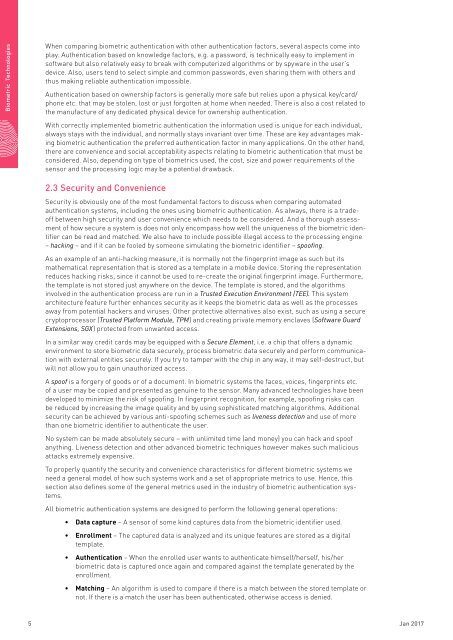BIOMETRIC
Fingerprints-Biometric-Technologies-Whitepaper-January-2017-RevB
Fingerprints-Biometric-Technologies-Whitepaper-January-2017-RevB
You also want an ePaper? Increase the reach of your titles
YUMPU automatically turns print PDFs into web optimized ePapers that Google loves.
Biometric Technologies<br />
When comparing biometric authentication with other authentication factors, several aspects come into<br />
play. Authentication based on knowledge factors, e.g. a password, is technically easy to implement in<br />
software but also relatively easy to break with computerized algorithms or by spyware in the user’s<br />
device. Also, users tend to select simple and common passwords, even sharing them with others and<br />
thus making reliable authentication impossible.<br />
Authentication based on ownership factors is generally more safe but relies upon a physical key/card/<br />
phone etc. that may be stolen, lost or just forgotten at home when needed. There is also a cost related to<br />
the manufacture of any dedicated physical device for ownership authentication.<br />
With correctly implemented biometric authentication the information used is unique for each individual,<br />
always stays with the individual, and normally stays invariant over time. These are key advantages making<br />
biometric authentication the preferred authentication factor in many applications. On the other hand,<br />
there are convenience and social acceptability aspects relating to biometric authentication that must be<br />
considered. Also, depending on type of biometrics used, the cost, size and power requirements of the<br />
sensor and the processing logic may be a potential drawback.<br />
2.3 Security and Convenience<br />
Security is obviously one of the most fundamental factors to discuss when comparing automated<br />
authentication systems, including the ones using biometric authentication. As always, there is a tradeoff<br />
between high security and user convenience which needs to be considered. And a thorough assessment<br />
of how secure a system is does not only encompass how well the uniqueness of the biometric identifier<br />
can be read and matched. We also have to include possible illegal access to the processing engine<br />
– hacking – and if it can be fooled by someone simulating the biometric identifier – spoofing.<br />
As an example of an anti-hacking measure, it is normally not the fingerprint image as such but its<br />
mathematical representation that is stored as a template in a mobile device. Storing the representation<br />
reduces hacking risks, since it cannot be used to re-create the original fingerprint image. Furthermore,<br />
the template is not stored just anywhere on the device. The template is stored, and the algorithms<br />
involved in the authentication process are run in a Trusted Execution Environment (TEE). This system<br />
architecture feature further enhances security as it keeps the biometric data as well as the processes<br />
away from potential hackers and viruses. Other protective alternatives also exist, such as using a secure<br />
cryptoprocessor (Trusted Platform Module, TPM) and creating private memory enclaves (Software Guard<br />
Extensions, SGX) protected from unwanted access.<br />
In a similar way credit cards may be equipped with a Secure Element, i.e. a chip that offers a dynamic<br />
environment to store biometric data securely, process biometric data securely and perform communication<br />
with external entities securely. If you try to tamper with the chip in any way, it may self-destruct, but<br />
will not allow you to gain unauthorized access.<br />
A spoof is a forgery of goods or of a document. In biometric systems the faces, voices, fingerprints etc.<br />
of a user may be copied and presented as genuine to the sensor. Many advanced technologies have been<br />
developed to minimize the risk of spoofing. In fingerprint recognition, for example, spoofing risks can<br />
be reduced by increasing the image quality and by using sophisticated matching algorithms. Additional<br />
security can be achieved by various anti-spoofing schemes such as liveness detection and use of more<br />
than one biometric identifier to authenticate the user.<br />
No system can be made absolutely secure – with unlimited time (and money) you can hack and spoof<br />
anything. Liveness detection and other advanced biometric techniques however makes such malicious<br />
attacks extremely expensive.<br />
To properly quantify the security and convenience characteristics for different biometric systems we<br />
need a general model of how such systems work and a set of appropriate metrics to use. Hence, this<br />
section also defines some of the general metrics used in the industry of biometric authentication systems.<br />
All biometric authentication systems are designed to perform the following general operations:<br />
••<br />
Data capture – A sensor of some kind captures data from the biometric identifier used.<br />
••<br />
Enrollment – The captured data is analyzed and its unique features are stored as a digital<br />
template.<br />
••<br />
Authentication – When the enrolled user wants to authenticate himself/herself, his/her<br />
biometric data is captured once again and compared against the template generated by the<br />
enrollment.<br />
• • Matching – An algorithm is used to compare if there is a match between the stored template or<br />
not. If there is a match the user has been authenticated, otherwise access is denied.<br />
5 Jan 2017


